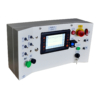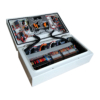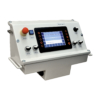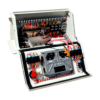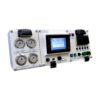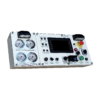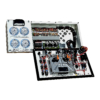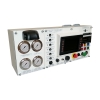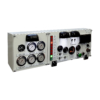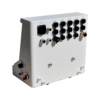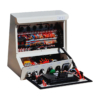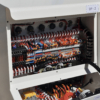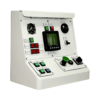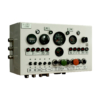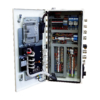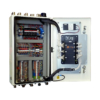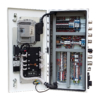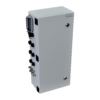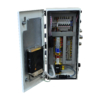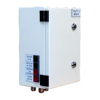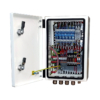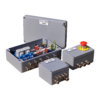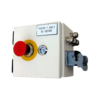Pulpity sterownicze do maszyn samojezdnych
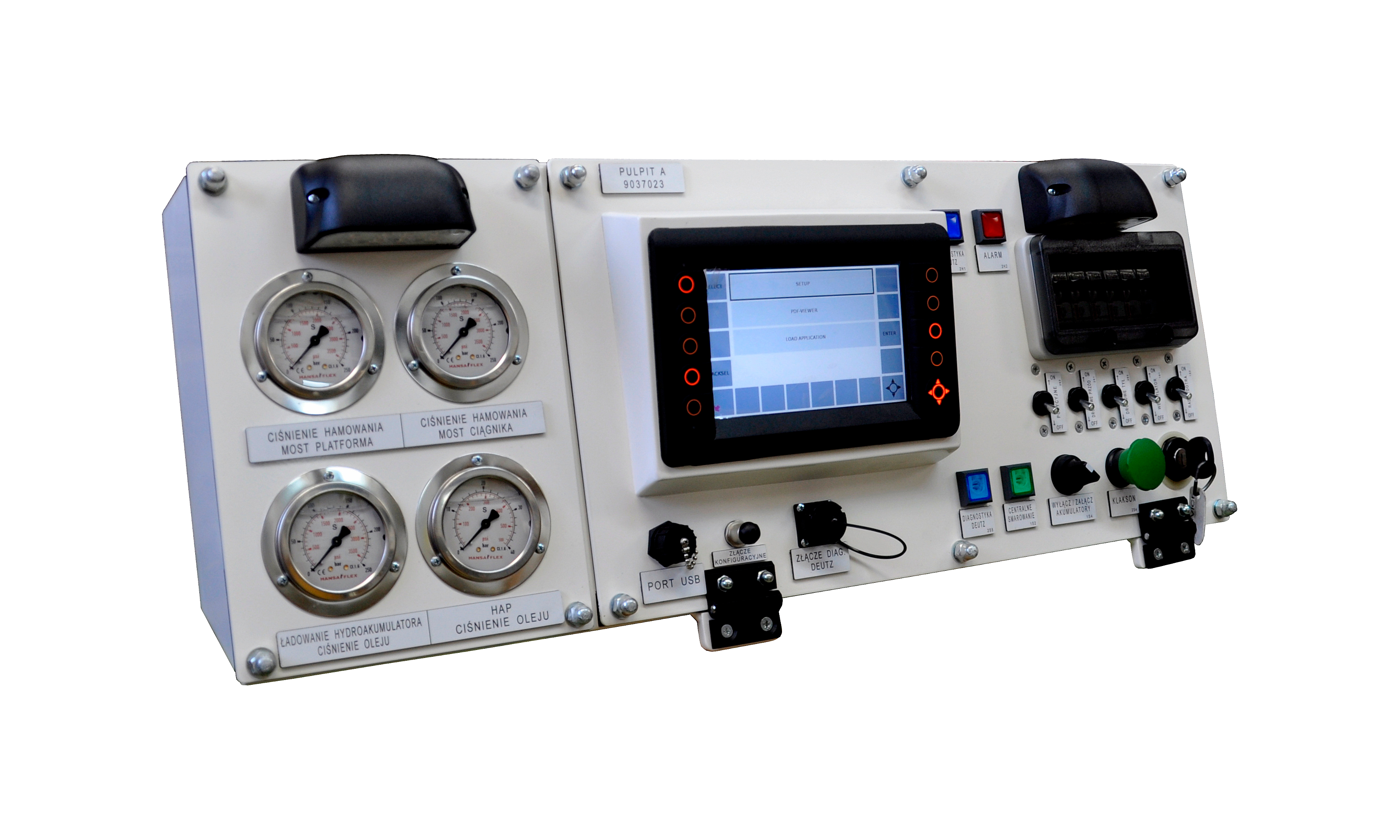
JS INTEGRAL wykonuje pulpity sterownicze do maszyn samojezdnych na zlecenie Klienta, zgodnie z dostarczoną dokumentacją (elektryczną i mechaniczną) i uzgodnieniami technicznymi, z uwzględnieniem odnoszących się do nich wymagań norm PN-EN, w tym norm górniczych.
Ze względu na przeznaczenie i rodzaj wykonywanych funkcji, do produktów tej podgrupy zaliczamy:
- pulpity operatorów maszyn (najbardziej zaawansowane technologicznie)
- pulpity sterowniczo-sygnalizacyjne
- skrzynki sterownicze
Uzupełnienie asortymentu stanowią wiązki przewodów elektrycznych do maszyn, wykonywane zgodnie z dokumentacją Klienta.
Zastosowanie
- do sterowania maszynami samojezdnymi
- do zabezpieczania urządzeń elektrycznych i elementów wykonawczych maszyn przed skutkami zwarć i przeciążeń
- do monitorowania parametrów pracy maszyn (czas pracy, ciśnienie i temperatura płynów eksploatacyjnych, zużycie paliwa, klimatyzacja i inne)
Przeznaczenie
Pulpity sterownicze przeznaczone są do maszyn samojezdnych, stosowanych:

- w górnictwie rud metali, w szczególności rud miedzi
- w przemyśle wydobywczym surowców mineralnych
- w budownictwie tunelowym
- w budownictwie infrastrukturalnym w robotach budowlanych, drogowych, w pracach ziemnych i innych
Wykonanie
Każdy pulpit sterowniczy wykonywany jest zgodnie z dokumentacją Klienta w obudowach z blachy stalowej, nierdzewnej lub kwasoodpornej.
Gabaryty pulpitów, ich ergonomiczny kształt (w szczególności pulpity operatorów maszyn) oraz logiczne i funkcjonalne rozmieszczenie aparatury sygnalizacyjno-sterowniczej na płytach czołowych pulpitów ułatwiają operatorom sterowanie maszynami.
Wersje wykonania:
- pulpity operatorskie montowane na konstrukcji wewnątrz kabiny operatorów maszyn
- pulpity sterowniczo-sygnalizacyjne i skrzynki sterownicze montowane w specjalnych wnękach lub na konstrukcji maszyny
Zamknięcia płyt czołowych, drzwi i pokryw pulpitów oraz skrzynek (połączenia śrubowe, zamki, zawiasy, uszczelki) – dostosowane są do ich gabarytów i wymagań stopnia ochrony IP.
Elementy montażowe: płyty i szyny montażowe, uchwyty, wsporniki oraz profile montażowe – zapewniają optymalną konfigurację pulpitów i skrzynek sterowniczych.
Wyposażenie
Typowy pulpit sterowniczy do maszyn i urządzeń stacjonarnych wyposażany jest w aparaturę modułową (w tym elementy łączeniowe), przystosowaną do montażu na standardowych szynach montażowych TH 35 i innych. Ponadto na płytach montażowych i wspornikach wewnątrz obudowy pulpitów, na płytach czołowych i drzwiach pulpitów mogą być montowane dodatkowe pojedyncze aparaty.
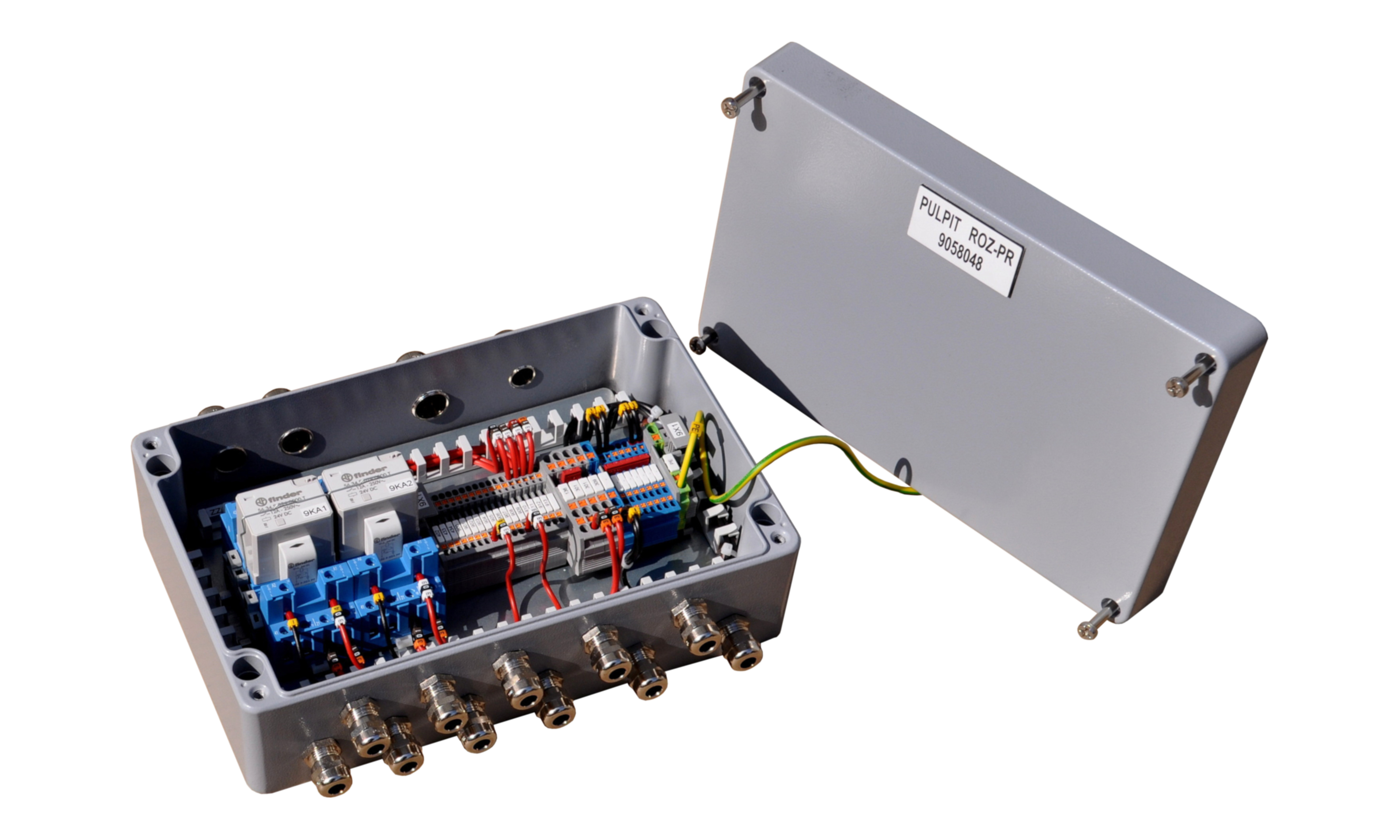
Podstawowe wyposażenie pulpitów sterowniczych w zależności od wersji wykonania stanowi:
- aparatura elektryczna – sygnalizacyjna, sterownicza, rozdzielcza, zabezpieczająca, zasilająca, w tym elementy łączeniowe
- aparatura elektroniczna – komputery z wyświetlaczami danych, sterowniki, przekaźniki „inteligentne”, gniazda USB i inne
- aparatura sygnalizacyjno-pomiarowa – sygnalizatory (np. dźwięku), wskaźniki temperatury i ciśnienia oleju, wskaźniki poziomu paliwa, licznik motogodzin, manometry i inne
- okablowanie – wykonywane przewodami izolowanymi o wymaganym napięciu znamionowym izolacji, wymaganej odporności mechanicznej, kolorystyce i przekrojach dobranych do określonej obciążalności prądowej i rodzaju aparatury
Dane techniczne
- napięcie znamionowe łączeniowe; Uzn dla urządzeń zasilających – 230V / 400V lub 500V AC
- napięcie znamionowe łączeniowe; Uzn dla pulpitów sterowniczych – 24V DC
- napięcie znamionowe izolacji Ui – do 1000V
- częstotliwość znamionowa – 50 / 60 Hz
- prąd znamionowy ciągły Izn – do 250 A AC
- stopień ochrony IP – 54-65
- stopień odporności mechanicznej IK – 10
- klasa ochronności – I
Przykładowe realizacje
Control panels for self-propelled machines

JS INTEGRAL manufactures control panels for self-propelled machines based on documentation provided by the customer (electrical and mechanical), complying with the relevant requirements of PN-EN standards, including mining standards.
Depending on the application and functionality, we offer the following types of control panels:
- machine operator control panel (the most advanced technologically)
- signal-control panel
- control box
The control panel product range is complemented by the electrical wiring harnesses, manufactured based on customer’s documentation.
Application
- to control self-propelled machines
- to protect electrical devices of machines against the effects of short circuits and overloads
- to monitor machine operating parameters (working time, fluids pressure and temperature, fuel consumption, air conditioning and others)
Usage

Control panels are intended for self-propelled machines used in:
- mining of metal ores, especially copper ores
- mining and processing of mineral resources
- tunnel construction
- infrastructure construction in road works, earth works and others
Construction
Control panels for self-propelled machines are manufactured in steel, stainless or acid-resistant steel housings
The size, ergonomic shape (in particular machine operator control panel), and the logical and functional arrangement of the signalling and control equipment on the front panel of the control panel make it easy for operators to control the machines
Versions:
- machine operator control panels mounted on the inside of the operator’s cabin
- signal-control panels and control boxes mounted in special recesses or on machine frame
Closures of front panels, doors and lids of control panels and boxes (screw connections, locks, hinges, gaskets) – are adapted to their size and IP protection requirements
Mounting elements: boards and mounting rails, handles, brackets and mounting profiles – provide optimum configuration of control panels and boxes
Equipment
Control panels for self-propelled machines are equipped with modular equipment (including connection elements) adapted for mounting on standard TH35 rails and others. They are also equipped with single devices mounted on mounting plates, brackets inside the housing, as well as on front panels and housing doors.

The basic equipment of the control panels, depending on the version, is as follows:
- electric equipment – signal, control, distribution, security, measuring and switching equipment, including connecting elements
- electronic equipment – computers with data displays, controllers, “smart” relays, USB sockets and more
- signalling and measuring equipment – signalling devices (eg sound), oil temperature and pressure gauges, fuel level gauges, hour meters, manometers and other
- wiring – insulated wires with the required rated insulation voltage, required mechanical resistance, color and cross-sections selected for specific current carrying capacity and type of equipment
Technical specification
- rated voltage Uzn – power supplies – 230V / 400V lub 500V AC
- rated voltage Uzn – control panels – 24V DC
- rated insulation voltage Ui – do 1000V
- rated frequency – 50 / 60 Hz
- continuous current Izn – do 250 A AC
- degree of protection IP – 54-65
- mechanical resistance degree IK – 10
- protection class – I
Example products
Steuerpulte für mobile Maschinen

JS INTEGRAL fertigt Steuerpulte für mobile Maschinen gemäß Kundenauftrag, gemäß der gelieferten (elektrischen und mechanischen) Dokumentation und den technischen Spezifikationen, unter Berücksichtigung der Anforderungen der PN-EN-Normen, einschließlich der Bergbau-Normen.
Aufgrund des Zwecks und der Art der ausgeführten Funktionen gehören zu den Produkten dieser Untergruppe:
- Bedienpulte von Maschinen und Anlagen
- Steuer- und Signalpulte
- Steuerkästen
Das Sortiment umfasst auch Bündel von elektrischen Kabeln für Maschinen, die nach den Unterlagen des Kunden angefertigt werden.
Einsatzbereiche
- zur Steuerung mobiler Maschinen
- zum Schutz von elektrischen Betriebsmitteln und Ausführungselementen vor Kurzschluss und Überlastung
- zur Überwachung der Betriebsparameter von Maschinen und Anlagen (Arbeitszeit, Betriebsmitteldruck und -temperatur, Kraftstoffverbrauch, Klimaanlagen u. a.)
Bestimmung
Die Bedienpulte sind für mobile Maschinen konzipiert und werden eingesetzt:

- beim Abbau von Metallerzen, insbesondere Kupfererzen
- bei der Gewinnung von Mineralrohstoffen
- beim Tunnelbau
- beim Infrastrukturbau im Baugewerbe, Straßen- und Erdbau sowie bei anderen Bautätigkeiten
Ausführung
Steuerpulte werden nach Kundendokumentation in Gehäusen aus Stahlblech bzw. aus rostfreiem oder säurebeständigem Stahl gefertigt.
Die Abmessungen der Pulte, ihre ergonomische Form (insbesondere bei Bedienpulten für Maschinenführer) sowie die logische und funktionelle Anordnung von Signal- und Steuergeräten an den Frontplatten dieser Pulte erleichtern dem Bediener die Steuerung von Maschinen bzw. Geräten.
Ausführungsvarianten:
- Bedienpulte, die auf einer Konstruktion innerhalb der Bedienerkabine montiert werden
- Bedien- und Signalpulte sowie Steuerkästen, die in speziellen Nischen oder auf Maschinenkonstruktionen montiert werden
Verschlüsse von Frontplatten, Türen und Pultabdeckungen sowie Kästen (Schraubverbindungen, Schlösser, Scharniere, Dichtungen) – entsprechend den jeweiligen Abmessungen und Anforderungen der IP-Schutzart.
Befestigungselemente: Montageplatten und -schienen, Griffe, Halterungen und Montageprofile – diese sorgen für die optimale Konfiguration von Bedienpulten und Schaltschränken.
Ausstattung
Steuerpulte für mobile Maschinen sind mit modularen Geräten (einschließlich Schaltelementen), die sich für die Montage auf standardmäßigen TH35- und anderen Tragschienen eignen. Darüber hinaus werden Einzelgeräte an Montageplatten und Konsolen im Inneren des Pultgehäuses sowie an Frontplatten und Pultentüren eingesetzt.

Die Grundausstattung der Bedienpulte besteht je nach Ausführung aus:
- elektrischen Betriebsmitteln – Signaltechnik, Steuergeräte, Schaltanlagen, Schutz- und Versorgungseinrichtungen, einschließlich Schaltelemente
- elektronischen Geräten – Computer mit Datenanzeigen, Controller, „intelligente“ Relais, USB-Ports und andere Geräte
- Signal- und Messtechnik – Signalgeräte (z. B. akustische), Temperatur- und Öldruckanzeiger, Kraftstoffstandsanzeiger, Betriebsstundenzähler, Manometer und andere Anzeigen und Messer
- Verkabelung – hergestellt mit isolierten Leitungen, die sich durch die erforderliche Nennisolationsspannung und die geforderte mechanische Beständigkeit auszeichnen sowie deren Farben und Querschnitte auf die definierte Strombelastbarkeit und den spezifizierten Gerätetyp abgestimmt wurden
Technische Daten
- Nennschaltspannung Uzn für Stromversorgungsgeräte – 230V / 400V oder 500V AC
- Nennschaltspannung Uzn für Steuerpulte – 24V DC
- Nennisolationsspannung Ui – bis 1000V
- Frequenzbewertung – 50 / 60 Hz
- Nenndauerstrom Izn – bis 250 A AC
- Schutzart IP – 54-65
- mechanische Widerstandsfähigkeit IK – 10
- Schutzklasse – I
